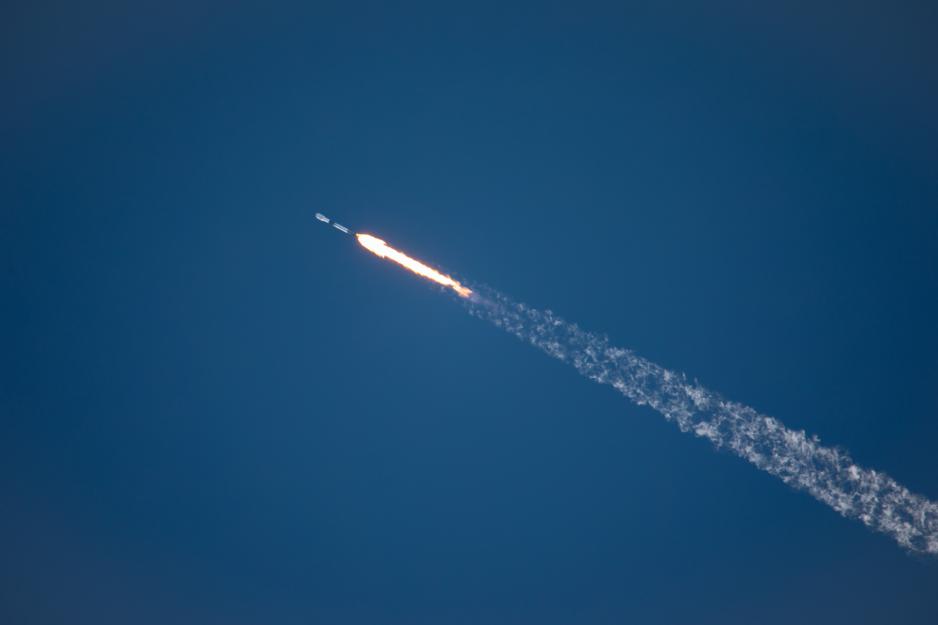Successfull Launch: The Arctic To Gain Full Broadband Coverage With Norwegian Satellites

Here, the 70-meter-long SpaceX Falcon 9 rocket launches Space Norway’s Arctic Satellite Broadband Mission from Vandenberg Space Force Base in California. After being placed in the right transfer orbit, the satellites will spend about ten days finding their highly elliptical orbit. (Photo: Space Norway)
Space Norway’s two satellites for Arctic broadband have now been launched into space from the US West Coast. These will provide continuous connectivity across the circumpolar North for both civilian and military users, whether at sea, in the air, or on land. "A milestone for Norway," says the Norwegian Minister of Trade and Industry.
On Sunday, Norway’s largest space project to date had its lift-off:
At 7:02 p.m. PT, two Norwegian-owed satellites were launched with SpaceX’s Falcon 9 rocket at Vandenberg Space Force Base in California, USA.
These will operate in a highly elliptical orbit and provide continuous broadband coverage across the Arctic for the first time. Today, such coverage is either limited or unavailable in the High North, particularly between Svalbard and the North Pole.
The Arctic Satellite Broadband Mission (ASBM) is led by the company Space Norway, which is owned by the Norwegian Ministry of Trade, Industry, and Fisheries.
"We have received the first important signals from both satellites. They are now heading to their orbit, and this process will take a couple of weeks," the company reports.
Throughout the fall, the satellites will be tested and finally verified – and users in the Arctic are expected to benefit from the new broadband capacity from the new year.
Everyday life will become very different for e.g. fishing vessels, research vessels and cruise ships, civilian aviation, as well as coast guards and military forces.
"This is a milestone for Norway and will be of great use for all work happening in the Arctic," says the Minister of Trade and Industry, Cecilie Myrseth (Labour).
Of great significance
With this, Norway will have control over strategically important communication services in the North, maintains Norway's Minister of Defense Bjørn Arild Gram (Center).
"This satellite launch is not only important for Norwegian security and national control, but it is also of great significance for NATO," says Gram and continues:
"The High North is Norway's most important strategic area of interest. Climate change contributes to increased activity and expanded operational areas in the Arctic. The economic opportunities that follow the melting of sea ice are of interest to many."
"For the Norwegian Armed Forces, this entails better communication and overview of the North, thereby strengthening our ability to have situational awareness in our immediate areas. Broadband in the Arctic opens up even more opportunities to cooperate across defense branches and with our allies," adds the Chief of Defense, General Eirik Kristoffersen.
Space cooperation with the US
The ASBM program's cooperation partners and customers are the Norwegian Armed Forces – together with the US Space Force, the American communications company Viasat (after the acquisition of Inmarsat), and the EU Commission.
The ASBM satellites are carrying payloads for the first three to serve military and civilian radio spectrums, while the EU Commission has a radiation monitor instrument built by the Norwegian company IDEAS.
"This satellite program is ground-breaking through its unique cooperation between allied, state, and commercial interests. It showcases the potential of international cooperation, which is cost-effective and meets commercial and public needs simultaneously," says Kjell-Ove Orderud Skare, Program Director for ASBM in Space Norway.
"It is particularly worth noting the important and close collaboration we have had with the US Space Force, and this program is a fundamental pillar in the Norwegian-American space cooperation," Skare points out.
He highlights that this is the first time the US has sent a military payload aboard a non-American satellite.
More about the satellite program
• Space Norway initiated the Arctic Satellite Broadband Mission work in 2014.
• First, the company signed contracts with the Norwegian defense and the satellite service provider Inmarsat (now part of Viasat).
• Later, the US military forces and the EU Commission also showed interest – respectively, due to the need for broadband coverage in Alaska and mapping of the radiation environment, considering the planning of radiation protection for the next generation of Galileo satellites (Europe’s navigation system).
• The ASBM program was decided to be carried out in 2019, and the building of the satellites started at Northrop Grumman's factory in Virginia, USA.
• The two satellites measure 3x3x4 meters, have a wingspan of 27 meters, and weigh about 2 tonnes. The launch took place, as mentioned, under the auspices of the US space transport company SpaceX.
• Space Norway's subsidiaries HEOSAT and Kongsberg Satellite Services (KSAT) in Tromsø, Northern Norway, will cooperate on operating the satellites, which have a 15-year life span.
• The payloads on these satellites will be operated by the customers themselves. The Norwegian Armed Forces, for example, will manage its payload from its satellite station in Southern Norway, and the US Space Force will do the same from a ground station in Alaska.
• The project has an investment framework of about USD 450, and the satellite's capacity has been sold out for its entire lifespan.




